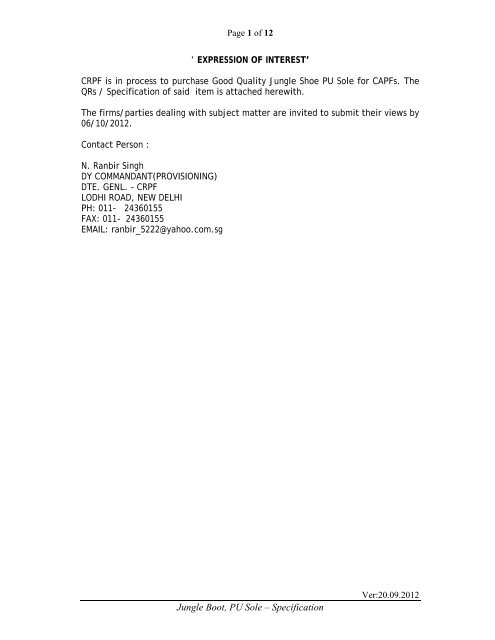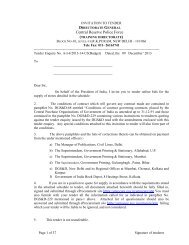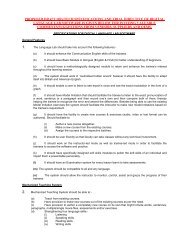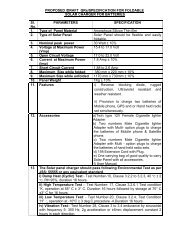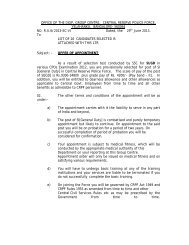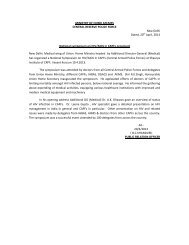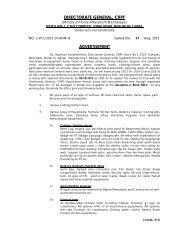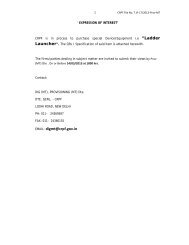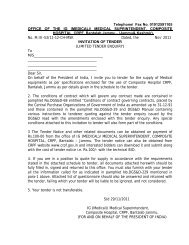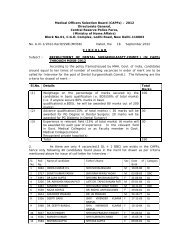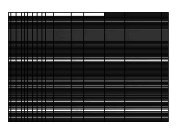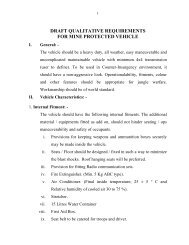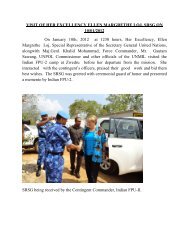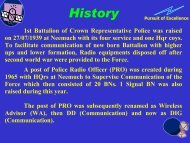Jungle Boot, PU Sole – Specification - Central Reserve Police Force
Jungle Boot, PU Sole – Specification - Central Reserve Police Force
Jungle Boot, PU Sole – Specification - Central Reserve Police Force
Create successful ePaper yourself
Turn your PDF publications into a flip-book with our unique Google optimized e-Paper software.
Page 1 of 12<br />
‘ EXPRESSION OF INTEREST’<br />
CRPF is in process to purchase Good Quality <strong>Jungle</strong> Shoe <strong>PU</strong> <strong>Sole</strong> for CAPFs. The<br />
QRs / <strong>Specification</strong> of said item is attached herewith.<br />
The firms/parties dealing with subject matter are invited to submit their views by<br />
06/10/2012.<br />
Contact Person :<br />
N. Ranbir Singh<br />
DY COMMANDANT(PROVISIONING)<br />
DTE. GENL. <strong>–</strong> CRPF<br />
LODHI ROAD, NEW DELHI<br />
PH: 011- 24360155<br />
FAX: 011- 24360155<br />
EMAIL: ranbir_5222@yahoo.com.sg<br />
<strong>Jungle</strong> <strong>Boot</strong>, <strong>PU</strong> <strong>Sole</strong> <strong>–</strong> <strong>Specification</strong><br />
Ver:20.09.2012
Page 2 of 12<br />
SPECIFICATION<br />
FOR<br />
BOOT ANKLE TEXTILE (JUNGLE BOOT), DIRECT INJECTED <strong>PU</strong> SOLE<br />
1. SCOPE<br />
1.1 This specification covers the requirement of <strong>Jungle</strong> <strong>Boot</strong> <strong>PU</strong> <strong>Sole</strong> in sizes 5 <strong>–</strong><br />
12.<br />
1.2 <strong>Jungle</strong> <strong>Boot</strong>s described in this specification has been designed to provide<br />
smart, durable and comfortable footwear to cater the needs of various State<br />
<strong>Police</strong> Organisations, Railways & <strong>Central</strong> Para Military <strong>Force</strong>s etc.<br />
1.3 The design also caters for adequate ankle support. It also meets the<br />
requirement of wear comfort for long hours. These boots are made with<br />
bucket type cleated <strong>PU</strong> sole and heel by Direct Injection Process.<br />
1.4 Materials are specified in this specification, so as to provide to provide added<br />
comfort and functionality while undertaking long combat actions. Instep<br />
support and cushioning is provided by way of moulded EVA rubber sheet as<br />
part full insocks.<br />
1.5 This specification covers the constructional, manufacturing and other<br />
requirements of the upper & lining fabric, <strong>PU</strong> <strong>Sole</strong> and other materials used in<br />
the manufacture of <strong>Jungle</strong> <strong>Boot</strong>s, Ankle High having <strong>PU</strong> <strong>Sole</strong> and Heel.<br />
2. REFERENCES<br />
Reference is made in this specification to the following:<br />
i) IS: 2050‐1991 Glossary of terms relating to footwear<br />
ii) IND/TC/0304 Laces Nylon Black<br />
iii) IS: 5041‐1978 <strong>Specification</strong> for Footwear and Stationery Eyelets<br />
iv) IS: 7329‐1974 Metal Lasts for canvas ankle boot<br />
(Reaffirmed 1986)<br />
v) IS:4905‐1968 Method of random sampling<br />
vi) IS: 15298 (Part 1) Requirements and test methods for Safety, Protective<br />
and occupational footwear for professional use<br />
The Standards mentioned above or anywhere in this specification contain<br />
provisions which through reference in this text, constitute provisions of this<br />
standard.<br />
3. TERMINOLOGY<br />
For the purpose of this specification the definitions and terminology given in<br />
IS:2050‐1991 are applicable<br />
4. STANDARD PATTERN<br />
Design: <strong>Boot</strong> shall be made to design shown in figure 1 on last IS No. 7329/74 or<br />
equivalent, broad toe, ‘H’ fitting last.<br />
<strong>Jungle</strong> <strong>Boot</strong>, <strong>PU</strong> <strong>Sole</strong> <strong>–</strong> <strong>Specification</strong><br />
Ver:20.09.2012
5. MATERIALS<br />
Page 3 of 12<br />
5.1 Upper : The upper shall consist of Polyester Viscose fabric conforming to<br />
the requirements given in annexure B as an outerlayer and 100% non<br />
woven nylon (cambrille type) lining conforming to the requirements given<br />
in annexure C as an inner layer or lining. The two fabrics shall be firmly<br />
adhered together with flexible adhesive & polyurethane foam of 5mm<br />
thickness. The upper together with lining shall be water repellant. Inside<br />
counter lining shall be of upper material The color/shade of upper used shall<br />
be Olive green<br />
5.2 Binding Materials: Made from Polyester or Cotton Dyed Black of best trade quality<br />
5.3 Toe Puff, Counter: For toe puffs and stiffeners well struck thermo plastic toe<br />
puff & stiffeners of minimum thickness 1.5 mm & 2 mm respectively shall be<br />
used.<br />
5.4 Eyelets: Aluminum Eyelets conforming to IS: 5041‐1978<br />
5.5 Insole: Insole will be non‐woven polyester fabric or thick cotton canvas of<br />
minimum thickness of 1.5 mm.<br />
5.6 Insock: Each boot shall be provided with a detachable 4.0 mm +_ 1.0 mm<br />
thick full insock of compress moulded EVA rubber having instep arch support.<br />
The outer layer of the insock shall be covered with Cambrelle type or drill<br />
cloth material in black colour.<br />
5.7 Laces: Each pair of boots shall be provided with a pair of Nylon Black Laces of<br />
130 cm long having minimum mass of 100 gms. per 10 Pairs<br />
5.8 Outsole: Shall be Polyurethane (<strong>PU</strong>) sole having anti‐slip design, moulded<br />
directly onto the lasted upper by Direct Injection Process. The design and<br />
pattern of <strong>PU</strong> <strong>Sole</strong> shall be similar to tread design of sole as shown in fig. 2 for<br />
reference. Physical requirements of <strong>PU</strong> sole are given in Annexure A<br />
5.9 The material used should meet the eco-friendly quality parameters as per<br />
Annexure D<br />
6. MANUFACTURE<br />
The <strong>Boot</strong> Ankle Textile (<strong>Jungle</strong> <strong>Boot</strong>) <strong>PU</strong> <strong>Sole</strong> shall be manufactured as described<br />
below:<br />
6.1 The boots shall be made by Direct Injection Process (DIP) of construction on<br />
lasts confirm dimensions of IS: 5520‐1969 or IS: 7329‐1974 or equivalent ‘H’<br />
fitting last.<br />
<strong>Jungle</strong> <strong>Boot</strong>, <strong>PU</strong> <strong>Sole</strong> <strong>–</strong> <strong>Specification</strong><br />
Ver:20.09.2012
Page 4 of 12<br />
6.2 The boots shall conform to the design and shape as illustrated in the fig.1<br />
attached to this specification. The front portion of the upper, comprising of<br />
vamp and toe cap, shall be lined. The toe cap and arch piece shall be of Black<br />
colour full chrome tanned leather.<br />
6.3 All upper components shall be cut in such a way to ensure adequate shaping of<br />
the components.<br />
6.4 The patterns of the quarters, vamp, lining, toe cap and toe puff etc. shall be so<br />
designed and shall be correctly fitted in such a way that these do not form<br />
excessive pleats at toe and counter regions during lasting.<br />
6.5 The upper components shall be stitched on lock‐stitch machine, which shall be<br />
reinforced with P.C. Black binding. Polyester / spun / nylon sewing thread shall be<br />
used for stitching.<br />
6.6 Full Chrome leather Toe Cap shall be reinforced with two rows of stitches to the<br />
vamp to cover the entire toe portion.<br />
6.7 The back seams shall be reinforced with 25 mm wide upper fabric and the edges shall<br />
be folded inside having inside turning of 12 mm on each side. The reinforcement shall<br />
also form a loop as shown in the drawing.<br />
6.8 The joining of quarter and vamp shall be done with two rows of stitches. The tab shall<br />
be reinforced with two parallel rows of stitches at a distance of 4 to 5 mm away from<br />
the face stitching and in the manner illustrated in the drawing. The length of tab<br />
stitches shall be between 10 to 12 mm.<br />
6.9 The tongue shall be full bellows made from upper fabric with cushion & lining and<br />
stitched with the vamp. The open end at the top of the tongue facing shall be bound<br />
with 13 mm wide P.C. binding tape stitched with one row of stitching using polyester<br />
sewing thread.<br />
6.10 After closing all ends of the stitching threads be tied and all seams hammered<br />
down.<br />
6.11 Tow Puff and stiffener components shall be correctly moulded after<br />
attachment.<br />
6.12 8 nos. aluminum eyelets of size no. 7.5 +_ 0.5 mm collar diameter shall be<br />
fitted in each face.<br />
6.13 The upper shall be stroble stitched to the insole.<br />
6.14 The Upper shall be force lasted after moulding of the counter and stiffeners.<br />
6.15 The <strong>PU</strong> sole shall be formed by direct reaction injection process . The sole<br />
shall be bucket /cup type and should be stitched with upper on the side<br />
wall all along the circumference.<br />
<strong>Jungle</strong> <strong>Boot</strong>, <strong>PU</strong> <strong>Sole</strong> <strong>–</strong> <strong>Specification</strong><br />
Ver:20.09.2012
Page 5 of 12<br />
6.16 The sole and heel flashes shall be neatly trimmed smooth.<br />
6.17 All closing seams on the finishing boot and stitches on the flange upper shall<br />
be given a suitable coating of <strong>PU</strong> adhesive in order to ensure that all needle<br />
holes are completely filled.<br />
6.18 A full insock of the specified material shall be struck down neatly on the<br />
insole.<br />
6.19 Each pair of boots shall be provided with a pair of Nylon Black Laces of 130 cm<br />
long.<br />
6.20 Each boot shall also have the “Name/Trade Mark of Manufacturer” and “Size<br />
of <strong>Boot</strong>” on the waist of outer sole, during mouding.<br />
6.21 The socks of the Shoe shall be legibly stamped with the manufacturers name/<br />
recognized trademark and size. Month & year of manufacture shall be marked<br />
on inside of the tongue.<br />
7. REQUIREMENTS AND TESTS<br />
7.1 The material used in the manufacture of boots shall be tested to the<br />
requirements given in this specification. All latest version of standards should<br />
be referred.<br />
7.2 Whole Footwear<br />
7.2.1 Mass<br />
The Mass of one pair of finished boots of Size 8 should be between 750 gm to<br />
900 gms with an increase or decrease of 50 gms for each bigger or smaller<br />
size respectively.<br />
7.2.2 Leg Height<br />
The leg height of the boots shall be 160+ _2 mm, for Size 8 with an increase or<br />
decrease by 2.0 mm for each bigger and smaller size, when measured from the<br />
inside of the back of the boot insole to the top. The leg height of the pair shall be<br />
equal<br />
7.2.3 Upper/Outsole Bond Strength<br />
When these boots are tested in accordance with the method given in IS:<br />
15298 Part‐1, the bond strength shall be no less than 3.0 N/mm.<br />
7.2.4 Electrical Resistance<br />
<strong>Jungle</strong> <strong>Boot</strong>, <strong>PU</strong> <strong>Sole</strong> <strong>–</strong> <strong>Specification</strong><br />
Ver:20.09.2012
Page 6 of 12<br />
When measured in accordance with the method described in IS: 15298 Part I<br />
after conditioning in a dry and wet atmosphere, the electrical resistance shall<br />
be not less than 100 kΩ and not greater than 1000 MΩ.<br />
7.2.5 Energy absorption of seat region<br />
When footwear is tested in accordance with the method described in IS:<br />
15298 Part I, the energy absorption of the seat shall be not less than 20 J<br />
7.2.6 Resistance to harsh environments<br />
7.2.6.1 Heat insulation of sole complex.<br />
When footwear is tested in accordance with the method described in<br />
IS: 15298 Part I, temperature increase on the upper surface of the<br />
insole shall be not greater than 22 o C<br />
7.2.6.2 Cold Insulation of sole complex<br />
When Footwear is tested in accordance with the method described in<br />
IS: 15298 Part I, the temperature decrease on the upper surface of the<br />
insole shall be not more than 10 oC<br />
7.2.7 Hydrolysis Test<br />
The <strong>Boot</strong>s shall be placed in High Humidity (100%) at a temperature of 70 o C<br />
for 5 days and then tested for whole shoe flexing for 100000 cycles. No Crack<br />
or damage to the sole is acceptable.<br />
7.3 Upper & Lining<br />
i) Upper (Outer Layer)<br />
Polyester Viscose Fabric Annexure‐B<br />
ii) Lining (Inner Layer)<br />
100%Non Woven Nylon (Cambrelle type) Fabric Annexure‐C<br />
7.4 Outsole<br />
7.4.1 Outer thickness and cleat height shall be as under:<br />
S.No. Description Thickness<br />
1. Minimum Thickness of sole 4 mm<br />
2. Cleat Height 2.5 mm (Min)<br />
3. Thickness of sole when measured<br />
from outside with side wall<br />
a. At Forepart<br />
b. At Waist<br />
c. At Heel<br />
<strong>Jungle</strong> <strong>Boot</strong>, <strong>PU</strong> <strong>Sole</strong> <strong>–</strong> <strong>Specification</strong><br />
20 mm (Min)<br />
16 mm (Min)<br />
35 mm (Min)<br />
Ver:20.09.2012
8. MARKING<br />
Page 7 of 12<br />
7.4.2 Physical requirements of Polyurethane <strong>Sole</strong><br />
<strong>PU</strong> <strong>Sole</strong> shall conform to the requirements as mentioned in Annexure A.<br />
8.1 Each boot shall be legibly marked by the manufacturer using indelible ink on<br />
the insock with the detail of Name / Trademark of the manufacturer,<br />
Nomenclature, Year of Manufacture, Size of the <strong>Boot</strong>.<br />
8.2 Month and Year of manufacture shall also be marked on inside of the tongue.<br />
9. SAMPLING AND CRITERIA FOR CONFORMITY<br />
9.1 Manufacturers/ Contractors must satisfy themselves first by carrying out<br />
thorough pre‐inspection of each lot/ batch that the stores manufactured are in<br />
accordance with the contract and fully conform to the specification, before<br />
tendering to QA officer nominated under the terms of contract.<br />
9.2 A declaration by the Contractor that necessary pre‐inspection/ tests have<br />
been carried out on the stores tendered and the same are fit for inspection and<br />
test shall be rendered along with the challan. The declaration shall include the<br />
method followed in pre‐inspection showing features checked / tested and the<br />
test reports be submitted along with challan.<br />
9.3 The jungle boot pairs of the same description nomenclature and of the same<br />
batch belonging to one size and fitting or a set of sizes and fittings offered<br />
against one challan shall constitute a lot.<br />
9.4 The lot size shall not exceed 10000 pairs.<br />
9.5 In all cases samples shall be drawn using technique of random sampling as per<br />
IS: 4905. The sampling officer shall first draw the samples for visual,<br />
dimensional, and construction parameters and for compliance to approved<br />
sample as per col 2 & 3 of the following table‐3.<br />
9.6 If found satisfactory on examination as above, the officer may draw (out of<br />
it) and send samples for lab testing as per col 2 & 5 of table‐3. The samples so<br />
drawn shall be subject to testing .(Composite testing)<br />
9.7 If found satisfactory, lot shall be accepted and inspection report shall be<br />
prepared.<br />
Table3: SAMPLING PLAN<br />
S. No. Lot Size in Pairs For Visual, Dimensional,<br />
Constructional Parameters and<br />
compliance to approved sample<br />
Number of<br />
samples to be<br />
drawn<br />
Permissible no.<br />
of non‐<br />
conforming<br />
samples<br />
<strong>Jungle</strong> <strong>Boot</strong>, <strong>PU</strong> <strong>Sole</strong> <strong>–</strong> <strong>Specification</strong><br />
For Laboratory Testing for<br />
Physical and Chemical Parameters<br />
Number of<br />
samples to be<br />
drawn<br />
Permissible no.<br />
of non‐<br />
conforming<br />
samples<br />
Ver:20.09.2012
Page 8 of 12<br />
(1) (2) (3) (4) (5) (6)<br />
1. Up to 2500 50 5 3 0<br />
2. 2501‐ 6000 90 8 5 0<br />
3. 6001‐10000 150 14 7 1<br />
10. PACKING<br />
10.1 Each pair of boots shall be wrapped in tissue paper and shall be packed in a<br />
three ply corrugated box that will form a unit pack.<br />
10.2 A paper label with Nomenclature, Manufacturer’s name/ Trade mark, Size and<br />
Month and Year of Manufacture shall be securely pasted on front of the unit<br />
box, which shall be clearly readable.<br />
10.3 Suitable number of unit packs shall further be packed in one corrugated<br />
carton strong enough to withstand transit hazards and to the satisfaction of<br />
inspecting officer.<br />
10.4 The Carton, thereafter shall be sealed with adhesive tapes and tape bound<br />
with polypropylene tapes. Each package shall be legibly marked with.<br />
11. STORAGE<br />
i. Nomenclature of the store.<br />
ii. Quantity packed in the package.<br />
iii. Lot and serial No. of the package.<br />
iv. Month and year of manufacturer.<br />
v. Gross mass of the package in kg.<br />
vi. Name and address of the consignee.<br />
vii. Name and recognized trade mark of the supplier.<br />
These <strong>Jungle</strong> <strong>Boot</strong>s with <strong>PU</strong> <strong>Sole</strong> shall have shelf life of minimum of 12 months for<br />
normal <strong>PU</strong> sole.<br />
<strong>Jungle</strong> <strong>Boot</strong>, <strong>PU</strong> <strong>Sole</strong> <strong>–</strong> <strong>Specification</strong><br />
Ver:20.09.2012
POLYURETHANE SOLE (DIP <strong>PU</strong> SOLE)<br />
Page 9 of 12<br />
PARAMETERS NORMS<br />
Shore “A”Hardness 50 to 60 Shore “A”<br />
Moulded density (kg/m 3 ) 500 to 600<br />
Trouser tear strength (IS 15298 part 1) in kN/m 5 Min.<br />
<strong>Jungle</strong> <strong>Boot</strong>, <strong>PU</strong> <strong>Sole</strong> <strong>–</strong> <strong>Specification</strong><br />
Annexure A<br />
Flexing life test (IS: 15298 part 1) 30,000 flexes cut growth 4mm max.<br />
Abrasion test, (IS: 15298 part 1) 250 mm 3 max.<br />
Hydrolysis test as per (IS: 15298 part 1) 6 mm cut growth maximum<br />
REQUIREMENTS OF UPPER MATERIAL<br />
Annexure B<br />
S.N Parameter Requirement/Norm Test Method<br />
1. Blend Composition<br />
a. Polyester (%):80 ± 3 IS: 11195<br />
(for Guidance)<br />
b. Viscose: Remainder<br />
2. Weave Twill 2/1 Visual<br />
3. Mass (gm / m2) 290 ± 10% IS: 1964<br />
4. Breaking Load in kg(min) (5x20<br />
cm strip)<br />
IS: 1969<br />
a. Warp<br />
200<br />
b. Weft<br />
100<br />
5. Elongation in % age 20 % (min.) IS: 1969<br />
6. Tear Strength in N, Min.<br />
IS:6489 Part 4<br />
a. Warp<br />
200<br />
b. Weft<br />
150<br />
7. Mullen Burst in Kg /cm2 10 (min.) IS:1966 Part-1<br />
8. pH Value 6.0 <strong>–</strong> 8.5 IS:1390 (Cold<br />
method)<br />
9. Colour Fastness<br />
a. Light<br />
4 or better<br />
IS: 2454<br />
b. Washing<br />
4 or better<br />
IS:764<br />
c. Perspiration<br />
4 or better<br />
IS: 971<br />
Ver:20.09.2012
Page 10 of 12<br />
Annexure C<br />
REQUIREMENTS OF NON-WOVEN LINING MATERIAL<br />
Sl. Parameter Requirement / Test Method<br />
No.<br />
Norm<br />
1. Blend Composition Nylon: 100% IS: 11195<br />
2. Weave Non Woven Visual<br />
3. Thickness 0.7mm (min.) -<br />
4. Mass (gm / m2) 150 ± 25 IS: 1964<br />
5. Tear Strength in N, Min 15 IS 15298 (part1)<br />
6. Mullen Burst in Kg / cm2 5 (min) IS:1966 Part-1<br />
7. Abrasion Martindale, Min 25,600 Cycles (dry)<br />
6400 Cycles (wet)<br />
IS 15298 Part 1<br />
8. Colour Fastness<br />
a. Light<br />
4 or better<br />
IS: 2454<br />
b. Washing<br />
4 or better<br />
IS:764<br />
c. Perspiration<br />
4 or better<br />
IS: 971<br />
<strong>Jungle</strong> <strong>Boot</strong>, <strong>PU</strong> <strong>Sole</strong> <strong>–</strong> <strong>Specification</strong><br />
Annexure D<br />
The material used should meet the following eco-friendly quality parameters:<br />
Sl Material Test Quality Norm Test Method<br />
1 Upper, lining fabric Azo dyes IS 14898 LC : 4 of IS 14816/ ISO<br />
17234/ ISO 14362<br />
Pentachlorophenol (PCP) IS 14575/ ISO 17070<br />
Formaldehyde LC : 3 of IS 14816/ ISO 17226<br />
2 <strong>Sole</strong> Lead IS 12254 IS 12240 (Part 5)/ EN 1122<br />
3 Metal parts eg<br />
eyelets, buckles, zip<br />
etc<br />
Nickel free SG Criteria DIN EN 12471<br />
Ver:20.09.2012
Page 11 of 12<br />
Ver:20.09.20112
Page 12 of 12<br />
<strong>Jungle</strong> <strong>Boot</strong>, <strong>PU</strong> <strong>Sole</strong> <strong>–</strong> <strong>Specification</strong><br />
Ver:20.09.2012


